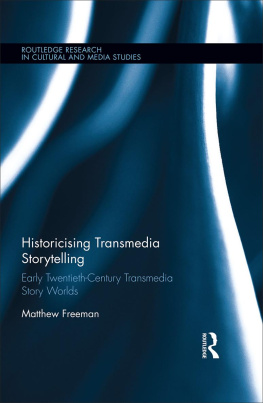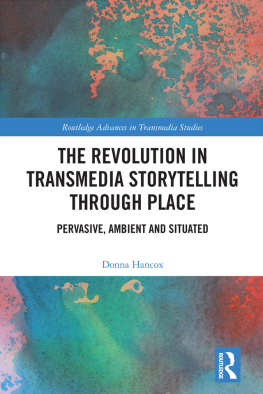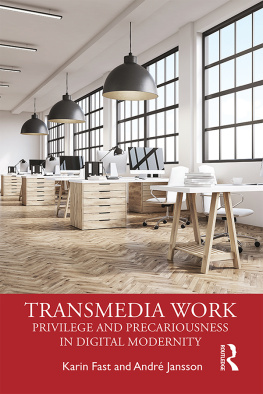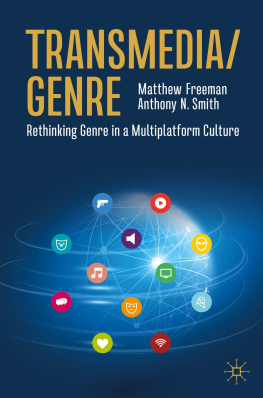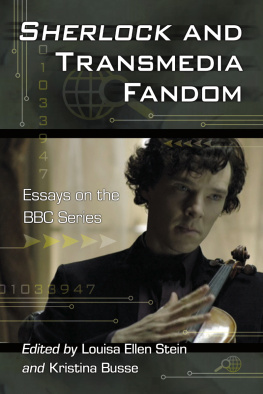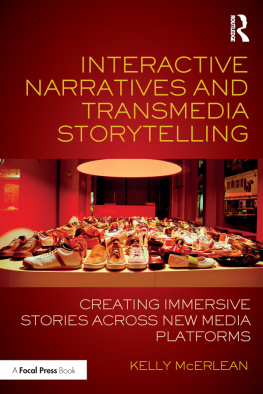The Rise of Transtexts
The discussions of transmediation are about to enter their adolescence and this book is a proof of this. It constitutes a fruitful dialogue between some of the seminal authors of transmedia studies to this day and as a whole makes a compelling case for not only the continuing importance of studying the complex storytelling practices of the convergence era, but demonstrates the many conflicts and tensions inherent to these practices as well as to the associated academic discourse.
Indrek Ibrus, University of Tallinn, Estonia
This volume builds on previous notions of transmedia practices to develop the concept of transtexts, in order to account for both the industrial and user-generated contributions to the cross-media expansion of a story universe. On the one hand exists industrial transmedia texts, produced by supposedly authoritative authors or entities and directed to active audiences in the aim of fostering engagement. On the other hand are fan-produced transmedia texts, primarily intended for fellow members of the fan communities, with the Internet allowing for connections and collaboration between fans. Through both case studies and more general analyses of audience participation and reception, employing the artistic, marketing, textual, industrial, cultural, social, geographical, technological, historical, financial and legal perspectives, this multidisciplinary collection aims to expand our understanding of both transmedia storytelling and fan-produced transmedia texts.
Benjamin W.L. Derhy Kurtz teaches at Sorbonne Nouvelle, Sciences Po (IEP) and Ecole Polytechnique, as well as at various communication and business schools. He created undergraduates/postgraduates courses, including on Transmedia, and holds experience in marketing and in institutional/promotional/political communication. His PhD, at the University of East Anglia, explored success in the TV industry. http://Derhy.TV
Mlanie Bourdaa is Associate Professor of Communication and Information Sciences at the University of Bourdeaux, France.
Routledge Research in Cultural and Media Studies
For a full list of titles in this series, please visit www.routledge.com.
87 The DIY Movement in Art, Music and Publishing
Subjugated Knowledges
Sarah Lowndes
88 Advertising and Public Memory
Social, Cultural and Historical Perspectives on Ghost Signs
Edited by Stefan Schutt, Sam Roberts and Leanne White
89 Postfeminist Celebrity and Motherhood
Brand Mom
Jorie Lagerwey
90 Technologies of Consumer Labor
A History of Self-Service
Michael Palm
91 Performing Ethnicity, Performing Gender
Transcultural Perspectives
Edited by Bettina Hofmann and Monika Mueller
92 Materiality and Popular Culture
The Popular Life of Things
Edited by Anna Malinowska and Karolina Lebek
93 Girlhood, Schools, and Media
Popular Discourses of the Achieving Girl
Michele Paule
94 The Creative Underground
Arts, Politics and Everyday Life
Paul Clements
95 Subjectivity across Media
Interdisciplinary and Transmedial Perspectives
Edited by Maike Sarah Reinerth and Jan-Nol Thon
96 The Rise of Transtexts
Challenges and Opportunities
Edited by Benjamin W.L. Derhy Kurtz and Mlanie Bourdaa
First published 2017
by Routledge
711 Third Avenue, New York, NY 10017
and by Routledge
2 Park Square, Milton Park, Abingdon, Oxon OX14 4RN
Routledge is an imprint of the Taylor & Francis Group, an informa business
2017 Taylor & Francis
The right of the editors to be identified as the authors of the editorial material, and of the authors for their individual chapters, has been asserted in accordance with sections 77 and 78 of the Copyright, Designs and Patents Act 1988.
All rights reserved. No part of this book may be reprinted or reproduced or utilised in any form or by any electronic, mechanical, or other means, now known or hereafter invented, including photocopying and recording, or in any information storage or retrieval system, without permission in writing from the publishers.
Trademark notice: Product or corporate names may be trademarks or registered trademarks, and are used only for identification and explanation without intent to infringe.
Library of Congress Cataloging-in-Publication Data
Names: Derhy Kurtz, Benjamin W.L., editor. | Bourdaa, Melanie, editor.
Title: The rise of transtexts: challenges and opportunities / edited byBenjamin W.L. Derhy Kurtz and Melanie Bourdaa.
Description: New York: Routledge, [2016] | Series: Routledge research incultural and media studies | Includes bibliographical references and index.
Identifiers: LCCN 2016021385
9781315671741 (ebk)
Subjects: LCSH: Mass mediaMarketing. | Mass mediaEconomic aspects.
Classification: LCC P96.M36 R57 2016 | DDC 302.23/0688dc23
LC record available at https://lccn.loc.gov/2016021385
ISBN: 978-1-138-94467-1 (hbk)
ISBN: 978-1-315-67174-1 (ebk)
Typeset in Sabon
by codeMantra
Toby Miller
Its a great pleasure to write some prefatory words to this collection. My remarks represent my sense of future directions that might aid our understanding of transmedia storytelling and encourage justice and democratization in how it works. I mostly leave commentary on the books compelling contents to its editors.
I can say this: The Rise of Transtexts is a real advance on previous work. It addresses commercial as well as amateur uses of transmedia storytelling, and pays heed to the steely eye of intellectual property in addition to the romantic gaze of troping fandom. I have learned a great deal from reading these fascinating chapters. Here, I want to provide some history, psychology, and political economy to help understand such practices.
The apparently iron laws of genre have always been malleable. Telling stories across mediaand with an eye to doing sois venerable, as Denzell Richards chapter acknowledges. Oral storytelling traditions had corollaries in song; both quickly made their peace with printed and recorded versions; and the typewriter has expanded its reach from letters, novels, poems, and journalism among elites and their amanuenses to be part of everyday life for billions of people around the world via telephone keyboards.
Novels have long been written and edited with a view to being optioned as screenplays; television programs have had books, toys, and clothes tied-in to them as merchandise since the beginnings of serial drama; Broadway plays were knowingly penned from the 1930s as future movies; and so it goes. Most importantly of all, the huge cultural warehouse of TV, the worlds most popular medium, continues to tell stories across platforms.
Intertextuality is everywhere and paratextuality a norm, even as intellectual property is constantly seeking to secure territory. When I wrote my study of The Avengers (the 196169 British TV program), I examined it as a television series, an industrial product, and the object of fan interpretation online and elsewhere. I uncovered decades of transmedia fan fiction about the series, from zines to family enactments and projections, and of course an abundance of corporate merchandising that both borrowed and added to the series, from mens trousers to womens caps, from novelizations to pop songs, from board games to radio shows (Miller, 1997).


